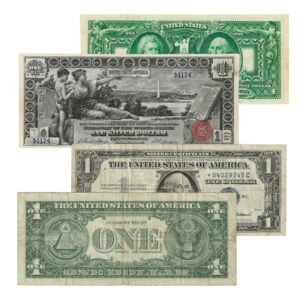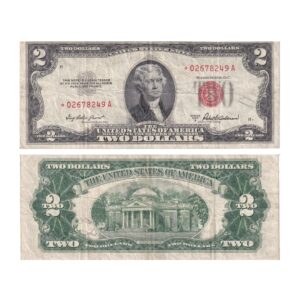Last updated on September 3rd, 2024 at 01:56 am
Last Updated on September 3, 2024 Posted by Colonial Acres Coins
The detailed history and artistic beauty of U.S. paper currency tell a captivating story of a nation’s past. Join us as we explore three iconic American banknotes, analyzing their designs, uncovering their historical significance, and highlighting the notable figures they feature. Discover the essence of each banknote, from the intricate details to the stories they hold, revealing the artistry and heritage that make these symbols of American currency special.
For both experienced collectors and beginners, we provide helpful tips on building and preserving your collection of interesting relics from the financial past. Join us on a journey through history to uncover the artistry and legacy of U.S. paper currency.
Three of America’s Iconic Banknotes
Three iconic U.S. banknotes are Silver Certificates, Federal Reserve Notes, and Star Notes. Each of these banknotes has played a crucial role in the nation’s financial history and is rich with unique features and stories. They stand as tangible assets reflecting intricate security measures and special printing processes, offering a glimpse into the complexities and innovations of American monetary history.
1) Silver Certificates
 Silver Certificates hold a special place in the history of U.S. paper money, serving as a critical component of the nation’s currency system from the late 19th century to the mid-20th century. First issued in 1878 under the Bland-Allison Act, Silver Certificates were a form of paper currency that could be redeemed for their face value in silver dollars. This linkage to silver provided a sense of security and stability in an era marked by economic fluctuations.
Silver Certificates hold a special place in the history of U.S. paper money, serving as a critical component of the nation’s currency system from the late 19th century to the mid-20th century. First issued in 1878 under the Bland-Allison Act, Silver Certificates were a form of paper currency that could be redeemed for their face value in silver dollars. This linkage to silver provided a sense of security and stability in an era marked by economic fluctuations.
One of the most iconic Silver Certificates is the 1896 series, often referred to as the “Educational Series” because of its elaborate, artistic designs. The $1 Silver Certificate from this series features “History Instructing Youth,” a beautiful allegorical depiction symbolizing the transfer of knowledge from one generation to another. This note is renowned for its intricate detail and is highly sought after by collectors for its artistic merit.
Another notable Silver Certificate is the 1923 series $1 note. Known as the “Horse blanket” due to its large size, this certificate prominently features a portrait of George Washington. It represents a bridge between earlier, larger notes and the smaller, modern-sized currency introduced in the following decade.
Silver Certificates continued to be issued until 1964, after which the U.S. Treasury ceased their production and redemption for silver. The 1957 series $1 Silver Certificate was among the last of its kind, bearing a simple yet dignified design with the familiar portrait of George Washington and the blue Treasury seal.
Today, Silver Certificates are cherished collectibles, embodying the nation’s historical reliance on silver and the enduring beauty of its paper currency.
2) Star Notes
 Star Notes are a special category of U.S. paper currency, distinguishable by a small star symbol positioned at the end of the serial number. These notes are issued as replacements for banknotes that did not pass quality control during the printing process. When a Federal Reserve Note is found to have a defect, it is removed from the production line and replaced with a Star Note to maintain accurate accounting and currency distribution.
Star Notes are a special category of U.S. paper currency, distinguishable by a small star symbol positioned at the end of the serial number. These notes are issued as replacements for banknotes that did not pass quality control during the printing process. When a Federal Reserve Note is found to have a defect, it is removed from the production line and replaced with a Star Note to maintain accurate accounting and currency distribution.
The process of printing currency is highly meticulous, involving multiple steps and various security features. Even with advanced technologies, there can still be instances of misprints, improper alignments, or other imperfections that render a note unusable. Rather than discarding the faulty note and leaving a gap in the serial number sequence, a Star Note, featuring the same value and series, is printed and inserted into the batch. The inclusion of the star ensures that the currency’s serial numbers remain sequentially intact, preserving the integrity of the monetary system.
Collectors often seek out Star Notes because of their relative rarity compared to regular notes. Since they are only produced on an as-needed basis to replace defective notes, their issuance is less frequent. The star symbol can be found on various denominations, including the frequently circulated $1 bills as well as higher denominations.
Star Notes not only signify a practical solution to quality control issues but also serve as a testament to the rigorous standards upheld in the production of U.S. currency. Collectors value these notes for their unique place in the history of U.S. paper currency, representing the meticulous processes behind each bill that enters circulation.
3) Federal Reserve Notes
 Federal Reserve Notes, the most widely recognized form of U.S. paper currency today, were introduced as part of the Federal Reserve Act of 1913. They represent the majority of banknotes currently in circulation and are distinguishable by their specific design elements, which include portraits of historical figures, identification of the issuing Federal Reserve Bank, and various security features aimed at preventing counterfeiting.
Federal Reserve Notes, the most widely recognized form of U.S. paper currency today, were introduced as part of the Federal Reserve Act of 1913. They represent the majority of banknotes currently in circulation and are distinguishable by their specific design elements, which include portraits of historical figures, identification of the issuing Federal Reserve Bank, and various security features aimed at preventing counterfeiting.
Federal Reserve Notes are unique in that thsey are issued by the 12 regional Federal Reserve Banks authorized by the Federal Reserve System. These reserve banks are located in major cities across the United States, each responsible for serving its region. The 12 cities hosting these regional banks include Boston, New York, Philadelphia, Cleveland, Richmond, Atlanta, Chicago, St. Louis, Minneapolis, Kansas City, Dallas, and San Francisco.
Every Federal Reserve Note has a specific letter and corresponding number that indicates which Federal Reserve Bank issued it.
For instance, a note with the letter “A” and the number “1” signifies it was issued by the Federal Reserve Bank of Boston. These identifiers are crucial for collectors and can add to the historical and monetary value of the notes.
Federal Reserve Notes feature a blend of intricate designs, including a combination of ink colours, watermarks, and microprinting. Notable figures such as Abraham Lincoln, Andrew Jackson, Alexander Hamilton, and Benjamin Franklin grace the denominations ranging from $5 to $100. Each note tells a story of America’s historical and cultural lineage, subtly merging artistic design with security innovations.
The production of Federal Reserve Notes follows a stringent process involving multiple checks to ensure each note’s authenticity and durability. These notes are made from a unique cotton-linen blend, making them more resistant to wear and tear compared to simple paper. Advanced features like colour-shifting ink, security threads, and 3D security ribbons further safeguard the integrity of the currency.
While originally designed to facilitate trade and economic stability, Federal Reserve Notes have transformed into symbols of the nation’s financial strength. They not only serve the practical function of facilitating day-to-day transactions but also embody the trust and stability of the U.S. monetary system.
Collecting U.S. Paper Money
Collecting U.S. paper money is a fascinating hobby that offers insight into the nation’s financial evolution while providing a fulfilling and potentially valuable pursuit. For both novice and seasoned collectors, understanding the historical context and recognizing the distinct features of various notes can significantly enhance the collecting experience. U.S. paper currency includes a broad spectrum of notes, each with its unique characteristics, historical significance, and potential for appreciation in value. From Silver Certificates and Federal Reserve Notes to the distinctive Star Notes, each type of currency offers collectors an opportunity to own a piece of American history.
For those looking to start or expand their collection of U.S. paper money, here are some helpful tips:
- Research and Educate Yourself: Familiarize yourself with the different types of U.S. paper currency, their historical backgrounds, and their distinguishing features.
- Check for Condition: The condition of a note greatly affects its value. Look for notes that are crisp, and free of tears, stains, or significant folds.
- Authentication: Ensure that the currency you are purchasing is genuine. Seek notes certified by reputable grading services.
- Serial Numbers: Pay attention to unique or low serial numbers, as these can enhance the note’s rarity and desirability.
- Storage and Preservation: Store your notes in a cool, dry place, and consider using protective sleeves or albums to prevent damage.
- Networking: Connect with fellow collectors, join clubs, and participate in online forums to share knowledge and gain insights.
- Continual Learning: Keep up with market trends and attend currency shows or auctions to stay informed about the latest developments in the hobby.
By following these tips, collectors can build a meaningful and valuable collection of U.S. paper money. This journey can deepen one’s appreciation for the intricate art, history, and meticulous craftsmanship behind each note, transforming paper currency into treasured collectibles.

Collecting U.S Banknotes at Colonial Acres Coins
Collecting U.S. paper money offers a unique glimpse into the intricate tapestry of America’s financial history. From the meticulous craftsmanship and security features of Federal Reserve Notes to the fascinating rarity of Star Notes, each piece of currency tells a story of economic evolution and cultural heritage. As a collector, delving into this captivating world not only provides a fulfilling hobby but also allows you to own a tangible slice of American history.
At Colonial Acres Coins, we understand the passion and dedication that goes into building a collection. Whether you’re looking for elusive Star Notes, pristine Federal Reserve Notes, or any other unique treasures, our extensive inventory caters to collectors at all levels. We pride ourselves on offering only the highest quality items, backed by our expertise and a commitment to authenticity. Visit our website or stop by our store to explore our curated selection and find the perfect addition to your collection. Start your journey with Colonial Acres Coins, where every note is a gateway to history.




